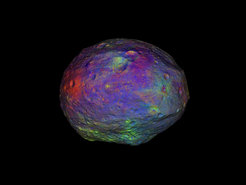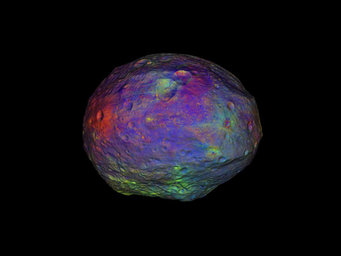A Farewell to Vesta
NASA's space probe Dawn is scheduled to leave asteroid Vesta on Wednesday, September 5th, and head for its next destination, the dwarf planet Ceres.
Approximately one year after arriving at the asteroid Vesta, NASA's spacecraft Dawn is now preparing for departure. The probe is scheduled to leave its orbit around Vesta on Wednesday, September 5th (CEST); the onboard camera system, that was developed and built under the lead of the Max Planck Institute for Solar System Research (MPS) in Germany, took its last snapshot of the asteroid on August 26th at 5.21 pm (CEST) from a distance of 6,000 kilometers. But the upcoming journey of almost two years and a half to Ceres will be far from eventless: The myriad of data collected by the scientific instruments on board within the last year still promises many surprises and insights.

„Already, Dawn has changed our understanding of the solar system“, says Dr. Holger Sierks, Co-Investigator of the Dawn mission and responsible for the development of the onboard camera system. „The data we have analyzed so far show, that Vesta is the only known representative of a new class of bodies“, he adds. With its diameter of 525 kilometers and its irregular form, Vesta is neither a planet, nor – strictly speaking- an asteroid. Instead, scientists refer to Vesta as a protoplanet. It remained stuck in an early phase of planetary evolution about 4,5 billion years ago. The data obtained by Dawn shows, that like Earth Vesta consists of a crust, a mantle, and a core. Thus, Vesta is the smallest known body that is structured in this way.
„Judging from our current state of knowledge, Vesta is in many respects unique“, says Sierks. As the second most massive body of the asteroid belt, Vesta is characterized by a unique topography: while the northern hemisphere presents itself as practically covered with craters in the images taken by the camera system, craters are more scarce in the south. There, directly at the South Pole in the Rheasilvia basin one of the highest mountains in the solar system can be found: It is more than twice as high as Mount Everest.
In addition, the mineralogical composition of Vesta's surface is unusual and extremely varied. „The seven color filters of the camera system allow us to infer what kinds of rock can be seen on the surface“, explains Sierks. Different materials reflect light of different wavelengths back into space. From this data, researchers at MPS were able to create complete three-dimensional color maps of Vesta. Also, the data collected in the past months shows clearly, that Vesta's brightness varies strongly. While the brightest regions reflect sunlight like snow, the darkest regions „swallow“ light similar to coal. Another important insight was the proof, that the so-called HED-meteorites, a large class of rocks from space found on Earth, originated from Vesta.
„The last year has proven impressively, how essential the camera system is for the mission's scientific goals“, says Sierks. The researchers are certain, that „Dawn's eyes“ will again play an important role, when the space probe reaches the dwarf planet Ceres – and will again offer a unique view of an unknown world.
The Dawn mission was launched approximately five years ago and entered orbit around Vesta on July 16th, 2011. In 2015 Dawn will arrive at its second destination, the dwarf planet Ceres, that like Vesta orbits the Sun between the orbits of Mars and Jupiter within the so-called asteroid belt. The Dawn mission to Vesta and Ceres is managed by NASA's Jet Propulsion Laboratory, a division of the California Institute of Technology in Pasadena, for NASA's Science Mission Directorate, Washington. The University of California, Los Angeles, is responsible for overall Dawn mission science. The Dawn framing cameras have been developed and built under the leadership of the Max Planck Institute for Solar System Research, Katlenburg-Lindau, Germany, with significant contributions by DLR German Aerospace Center, Institute of Planetary Research, Berlin, and in coordination with the Institute of Computer and Communication Network Engineering, Braunschweig. The Framing Camera project is funded by the Max Planck Society, DLR, and NASA/JPL.
